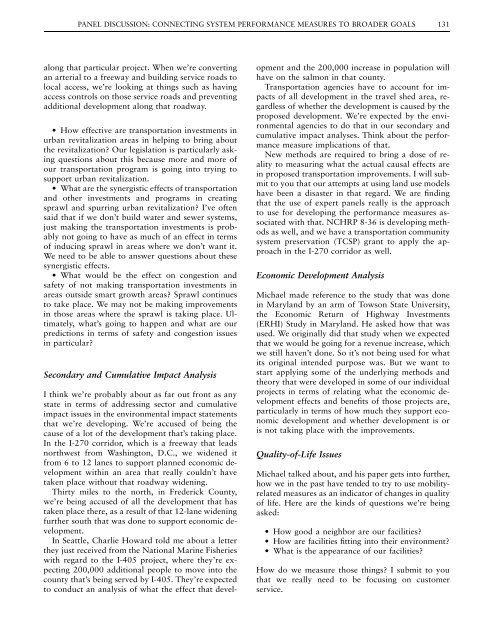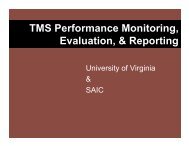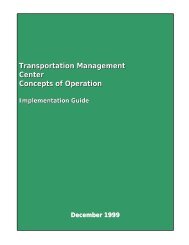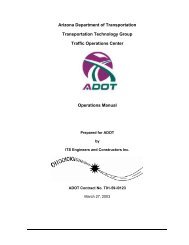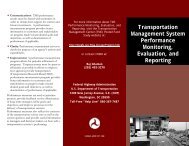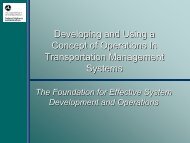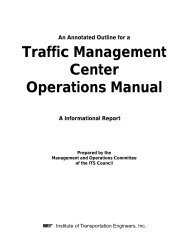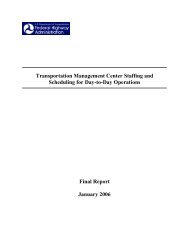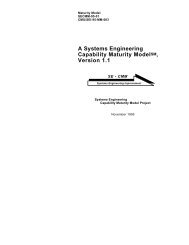Conference Proceedings 26 - Transportation Research Board
Conference Proceedings 26 - Transportation Research Board
Conference Proceedings 26 - Transportation Research Board
- No tags were found...
You also want an ePaper? Increase the reach of your titles
YUMPU automatically turns print PDFs into web optimized ePapers that Google loves.
PANEL DISCUSSION: CONNECTING SYSTEM PERFORMANCE MEASURES TO BROADER GOALS 131along that particular project. When we’re convertingan arterial to a freeway and building service roads tolocal access, we’re looking at things such as havingaccess controls on those service roads and preventingadditional development along that roadway.• How effective are transportation investments inurban revitalization areas in helping to bring aboutthe revitalization? Our legislation is particularly askingquestions about this because more and more ofour transportation program is going into trying tosupport urban revitalization.• What are the synergistic effects of transportationand other investments and programs in creatingsprawl and spurring urban revitalization? I’ve oftensaid that if we don’t build water and sewer systems,just making the transportation investments is probablynot going to have as much of an effect in termsof inducing sprawl in areas where we don’t want it.We need to be able to answer questions about thesesynergistic effects.• What would be the effect on congestion andsafety of not making transportation investments inareas outside smart growth areas? Sprawl continuesto take place. We may not be making improvementsin those areas where the sprawl is taking place. Ultimately,what’s going to happen and what are ourpredictions in terms of safety and congestion issuesin particular?Secondary and Cumulative Impact AnalysisI think we’re probably about as far out front as anystate in terms of addressing sector and cumulativeimpact issues in the environmental impact statementsthat we’re developing. We’re accused of being thecause of a lot of the development that’s taking place.In the I-270 corridor, which is a freeway that leadsnorthwest from Washington, D.C., we widened itfrom 6 to 12 lanes to support planned economic developmentwithin an area that really couldn’t havetaken place without that roadway widening.Thirty miles to the north, in Frederick County,we’re being accused of all the development that hastaken place there, as a result of that 12-lane wideningfurther south that was done to support economic development.In Seattle, Charlie Howard told me about a letterthey just received from the National Marine Fisherieswith regard to the I-405 project, where they’re expecting200,000 additional people to move into thecounty that’s being served by I-405. They’re expectedto conduct an analysis of what the effect that developmentand the 200,000 increase in population willhave on the salmon in that county.<strong>Transportation</strong> agencies have to account for impactsof all development in the travel shed area, regardlessof whether the development is caused by theproposed development. We’re expected by the environmentalagencies to do that in our secondary andcumulative impact analyses. Think about the performancemeasure implications of that.New methods are required to bring a dose of realityto measuring what the actual causal effects arein proposed transportation improvements. I will submitto you that our attempts at using land use modelshave been a disaster in that regard. We are findingthat the use of expert panels really is the approachto use for developing the performance measures associatedwith that. NCHRP 8-36 is developing methodsas well, and we have a transportation communitysystem preservation (TCSP) grant to apply the approachin the I-270 corridor as well.Economic Development AnalysisMichael made reference to the study that was donein Maryland by an arm of Towson State University,the Economic Return of Highway Investments(ERHI) Study in Maryland. He asked how that wasused. We originally did that study when we expectedthat we would be going for a revenue increase, whichwe still haven’t done. So it’s not being used for whatits original intended purpose was. But we want tostart applying some of the underlying methods andtheory that were developed in some of our individualprojects in terms of relating what the economic developmenteffects and benefits of those projects are,particularly in terms of how much they support economicdevelopment and whether development is oris not taking place with the improvements.Quality-of-Life IssuesMichael talked about, and his paper gets into further,how we in the past have tended to try to use mobilityrelatedmeasures as an indicator of changes in qualityof life. Here are the kinds of questions we’re beingasked:• How good a neighbor are our facilities?• How are facilities fitting into their environment?• What is the appearance of our facilities?How do we measure those things? I submit to youthat we really need to be focusing on customerservice.


